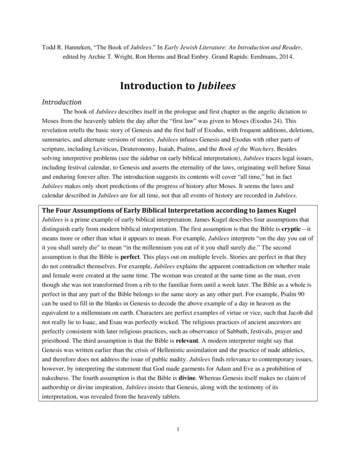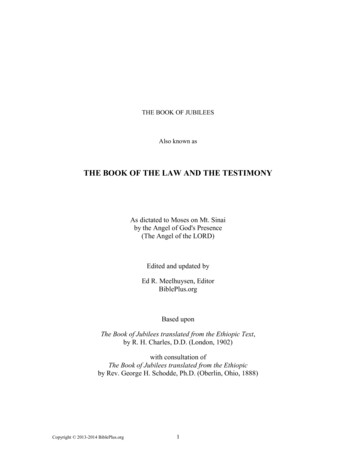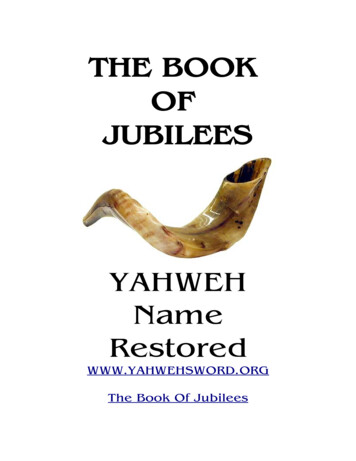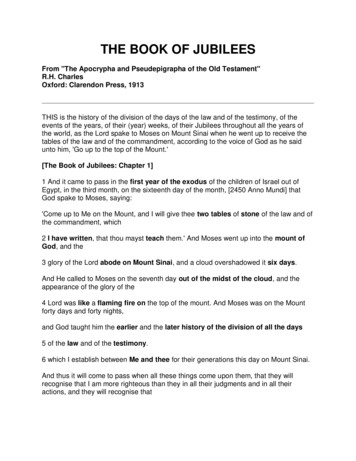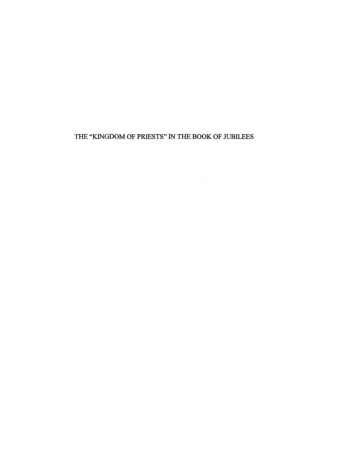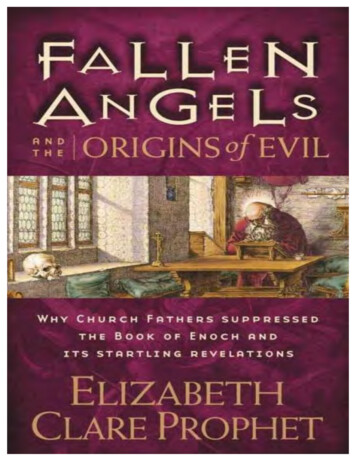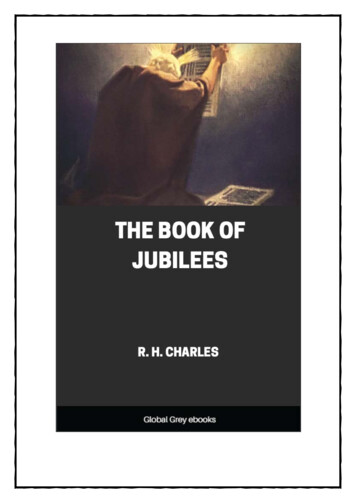
Transcription
THE BOOK OF JUBILEESORTHE LITTLE GENESISTRANSLATED FROM THE ETHIOPICTEXTBYR. H. CHARLES1917
The Book of Jubilees by R. H. Charles.This edition was created and published by Global Grey GlobalGrey 2018globalgreyebooks.com
CONTENTSEditors' PrefaceShort Account Of The BookTitlesVersions And Original LanguageAffinities With Other LiteratureThe Special Aims And General Character Of The BookAuthorship And DateBibliographyShort Titles, Abbreviations And Brackets Used In This EditionErratumThe Book Of Jubilees - PrologueGod's Revelation To Moses On Mount SinaGod Commands The Angel To Write (I. 27-29)The Angel Dictates To Moses The Primeval History: The Creation Of TheWorld And Institution Of The Sabbath (II. 1-33; Cf. Gen. I.-II. 3)Paradise And The Fall (III. 1-35; Cf. Gen. II. 4-III .)Cain And Abel (IV. 1-12; Cf. Gen. IV.)The Patriarchs From Adam To Noah (Cf. Gen. V.); Life Of Enoch; DeathOf Adam And Gain (IV. 13-33)The Fall Of The Angels And Their Punishment; The Deluge Foretold (V.1-20; Cf. Gen. VI. 1-12)The Building Of The Ark; The Flood (V. 21-32; Cf. Gen. VI. 13-VIII. 19)Noah's Sacrifice; God's Covenant With Him (Cf. Gen. VIII. 20-IX. 17).Instructions To Moses About Eating Of Blood, The Feast Of Weeks, Etc.,And Division Of The Year (VI. 1-38)Noah Offers Sacrifice; The Cursing Of Canaan (Cf. Gen. IX. 20-28):Noah's Sons And Grandsons (Cf. Gen. X.) And Their Cities. Noah'sAdmonitions (VII. 1-39)Genealogy Of The Descendants Of Shem: Noah And His Sons Divide TheEarth (VIII. 1-30; Cf. Gen. X.)
Subdivision Of The Three Portions Amongst The Grandchildren: OathTaken By Noah's Sons (IX. 1-15; Cf. Gen. X. Partly)Noah's Sons Led Astray By Evil Spirits; Noah's Prayer; Mastêmâ; DeathOf Noah (X. 1-17; Cf. Gen. IX. 28)The Tower Of Babel And The Confusion Of Tongues (X. 18-27; Cf. Gen.XI. 1-9)The Children Of Noah Enter Their Districts Canaan Seizes PalestineWrongfully; Madai Receives Media (X. 28-36)The History Of The Patriarchs From Reu To Abraham (Cf. Gen. XI, 2030); The Corruption Of The Human Race (XI. 1-15)Abram's Knowledge Of God And Wonderful Deeds (XI. 16-24)Abram Seeks To Convert Terah From Idolatry; The Family Of Terah (Cf.Gen. XI. 27-30). Abram Burns The Idols. Death Of Haran (Cf. Gen. XI.28) (XII. 1-14)The Family Of Terah In Haran; Abram's Experiences There; His JourneyTo Canaan (XII. 15-31; Cf. Gen. XI, 31-XII. 3)Abram With Lot In Canaan And Egypt (Cf. Gen. XII. 4-20). AbramSeparates From Lot (Cf. Gen. XIII. 11-18) (XIII. 1-21)The Campaign Of Chedorlaomer (XIII. 22-29; Cf. Gen. XIV.)God's Covenant With Abram (XIV. 1-20; Cf. Gen. XV.)The Birth Of Ishmael (XIV. 21-24; Cf. Gen. XVI. 1-4. 11)The Feast Of First-Fruits Circumcision Instituted. The Promise Of Isaac'sBirth. Circumcision Ordained For All Israel (XV. 1-34; Cf. Gen. XVII.)Angelic Visitation Of Abraham In Hebron; Promise Of Isaac's BirthRepeated. The Destruction Of Sodom And Lot's Deliverance (XVI. 1-9;Cf. Gen. XVIII.-XIX.)Abraham At Beersheba. Birth And Circumcision Of Isaac (Cf. Gen. XXI.1-4). Institution Of The Feast Of Tabernacles (XVI. 10-31)The Expulsion Of Hagar And Ishmael (XVII. 1-14; Cf. Gen. XXI. 8-21)Mastêmâ Proposes To God That Abraham Shall Be Put To The Proof(XVI. 15-18)The Sacrifice Of Isaac: Abraham Returns To Beersheba (XVIII. 1-19; Cf.Gen. XXII. 1-19)
The Death And Burial Of Sarah (XIX. 1-9; Cf. Gen. XXIII.)Marriage Of Isaac And Second Marriage Of Abraham (Cf. Gen. XXIV. 15,XXV. 1-4); The Birth Of Esau And Jacob (Cf. Gen. XXV. 19 Ff.) (XIX. 1014)Abraham Loves Jacob And Blesses Him (XIX. 15-31)Abraham's Last Words To His Children And Grandchildren (XX. I-II)The Dwelling-Places Of The Ishmaelites And Of The Sons Of Keturah(XX. 12-13)Abraham's Last Words To Isaac (XXI. 1-25)Isaac, Ishmael And Jacob Join In Festival With Abraham For The LastTime. Abraham's Prayer (XXII. 1-9)Abraham's Last Words To And Blessings Of Jacob (XXII. 10-30)The Death And Burial Of Abraham (XXIII. 1-8; Cf. Gen. XXV. 7-10)The Decreasing Years And Increasing Corruption Of Mankind (XXIII. 917)The Messianic Woes (XXIII. 18-25). [Eschatological Partly.]Renewed Study Of The Law Followed By A Renewal Of Mankind. TheMessianic Kingdom And The Blessedness Of The Righteous (XXIII. 2632; Cf. Isa. LXV. 17 Ff. [Eschatological.]Isaac At The Well Of Vision: Esau Sells His Birthright (XXIV. 1-7; Cf.Gen. XXV. 11, 29-34)Isaac's Sojourn In Gerar And Dealings With Abimelech (XXIV. 8-27; Cf.Gen. XXVI.)Isaac Curses The Philistines (XXIV. 28-33)Rebecca Admonishes Jacob Not To Marry A Canaanitish Woman.Rebecca's Blessing (XXV. 1-23; Cf. Gen. XXVIII. 1-4)Jacob Obtains The Blessing Of The Firstborn (XXVI. 1-35; Cf. Gen.XXVII.)Rebecca Induces Isaac To Send Jacob To Mesopotamia. Jacob's DreamAnd View At Bethel (XXVII. 1-27; Cf. Gen. XXVIII.)Jacob's Marriage To Leah And Rachel; His Children And Riches(XXVIII. I-30; Cf. Gen. XXIX., XXX., XXXI. 1-2)
Jacob's Flight With His Family: His Covenant With Laban (XXIX. 1-12;Cf. Gen, XXXI.)Jacob, Reconciled With Esau, Dwells In Canaan And Supports HisParents (XXIX. 13-20; Cf. Gen. XXXII., XXXIII.)Dinah Ravished. Slaughter Of The Shechemites. Laws AgainstIntermarriage Between Israel And The Heathen. The Choice Of Levi(XXX. 1-26; Cf. Gen. XXXIV.)Jacob's Journey To Bethel And Hebron. Isaac Blesses Levi And Judah(XXXI. 1-25; Cf. Gen. XXXV.)Rebecca Journeys With Jacob To Bethel (XXXI. 26-32)Levi's Dream At Bethel; He Is Appointed To The Priesthood. JacobCelebrates The Feast Of Tabernacles And Offers Tithes. The InstitutionOf Tithes (XXXII. 1-15; Cf. Gen. XXXV.)Jacob's Visions. He Celebrates The Eighth Day Of Tabernacles. The BirthOf Benjamin And Death Of Rachel (XXXII. 16-34; Cf. Gen. XXXV.)Reuben's Sin With Bilhah. Laws Regarding Incest. Jacob's Children(XXXIII. 1-23; Cf. Gen. XXXV. 21-27)War Of The Amorite Kings Against Jacob And His Sons. Joseph SoldInto Egypt (Cf. Gen. XXXVII.). The Death Of Bilhah And Dinah (XXXIV.1-19)The Wives Of Jacob's Sons (XXXIV. 20-21)Rebecca's Last Admonitions And Death (XXXV. 1-27)Isaac's Last Words And Admonitions: His Death. The Death Of Leah(XXXVI. 1-24)Esau And His Sons Wage War With Jacob (XXXVII. 1-25)The War Between Jacob And Esau At The Tower Of Hebron. The DeathOf Esau And Overthrow Of His Forces (XXXVIII. 1-4)The Kings Of Edom (XXXVIII. 15-24; Cf. Gen. XXXVI. 31-39)Joseph's Service With Potiphar; His Purity And Imprisonment (XXXIX.1-13; Cf. Gen. XXXIX.)Joseph Interprets The Dreams Of The Chief Butler And The Chief Baker(XXXIX. 14-18; Cf. Gen. XL.)
Pharaoh's Dreams And Their Interpretation. Joseph's Elevation AndMarriage (XL. 1-13; Cf. Gen. XLI.)Judah's Incest With Tamar; His Repentance And Forgiveness (XLI. 1-28;Cf. Gen. XXXVIII.)The Two Journeys Of The Sons Of Jacob To Egypt (XLII. 1-25; Cf. Gen.XLII., XLIII.)Joseph Finally Tests His Brethren, And Then Makes Himself Known ToThem (XLIII. 1-24; Cf. Gen. XLIV., XLV.)Jacob, Celebrates The Feast Of First-Fruits And Journeys To Egypt. ListOf His Descendants. (XLIV. 1-34; Cf. Gen. XLVI. 1-28)Joseph Receives Jacob. The Land Of Egypt Is Acquired For Pharaoh.Jacob's Death And Burial (XLV. 1-16; Cf. Gen. XLVI. 28 Ff., XLVII. 11Ff.)The Death Of Joseph. The Bones Of Jacob's Sons (Except Joseph)Interred At Hebron. The Oppression Of Israel By Egypt (XLVI. 1-16; Cf.Gen. L.; Exod. I.)The Birth And Early Years Of Moses (XLVII. 1-12; Cf. Exod. II.)From The Flight Of Moses To The Exodus (XLVIII. 1-19; Cf. Exod. II. 15Ff., IV. 19-24, VII-XIV.)Regulations Regarding The Passover (XLIX. 1-23; Cf. Exod. XII.)Laws Regarding The Jubilees And The Sabbath (L. 1-13)
1EDITORS' PREFACETHE object of this series of translations is primarily to furnish studentswith short, cheap, and handy text-books, which, it is hoped, will facilitatethe study of the particular texts in class under competent teachers. But itis also hoped that the volumes will be acceptable to the general readerwho may be interested in the subjects with which they deal. It has beenthought advisable, as a general rule, to restrict the notes and commentsto a small compass; more especially as, in most cases, excellent works ofa more elaborate character are available. Indeed, it is much to be desiredthat these translations may have the effect of inducing readers to studythe larger works.Our principal aim, in a word, is to make some difficult texts, importantfor the study of Christian origins, more generally accessible in faithfuland scholarly translations.In most cases these texts are not available in a cheap and handy form. Inone or two cases texts have been included of books which are available inthe official Apocrypha; but in every such case reasons exist for puttingforth these texts in a new translation, with an Introduction, in this series.We desire to express our thanks to Canon Charles and Messrs. A. and C.Black, for their permission to reprint here the translation of The Book ofJubilees, published in 1902.W. O. E. OESTERLEY.G. H. Box.
2SHORT ACCOUNT OF THE BOOKTHE Book of Jubilees, or, as it is sometimes called, "the little Genesis,"purports to be a revelation given by God to Moses through the mediumof an angel (" the Angel of the Presence," i. 27), and containing a history,divided up into jubilee-periods of forty-nine years, from the creation tothe coming of Moses. Though the actual narrative of events is onlycarried down to the birth and early career of Moses, its author envisagesthe events of a later time, and in particular certain events of specialinterest at the time when he wrote, which was probably in the latteryears of the second century B.C., perhaps in the reign of the Maccabeanprince John Hyrcanus. Though distinguished from the Pentateuchproper ("the first Law," vi. 22), it presupposes and supplements thelatter. The actual narrative embraces material contained in the whole ofGenesis and part of Exodus. But the legal regulations given presupposeother parts of the Pentateuch, especially the so-called "Priest's Code" (P),and certain details in the narrative are probably intended to apply toevents that occurred in the author's own time (the latter years of thesecond century B.C.). The author himself seems to have contemplatedthe speedy inauguration of the Messianic Age, and in this respect hispoint of view is similar to that of the Apocalyptic writers. But his work,though it contains one or two passages of an apocalyptic character, isquite unlike the typical apocalypses. It is largely narrative based uponthe historical narratives in Genesis and Exodus, interspersed withlegends, and emphasizing certain legal practices (such as the strictobservance of the Sabbath, circumcision, etc.), and laying much stressupon their eternal obligation. But his main object was to inculcate areform in the regulation of the calendar and festivals, in place of theintercalated lunar calendar, which he condemns in the strongestlanguage. He proposes to substitute for this a solar calendar consisting of12 months and containing 364 days. The result of such a system is tomake all festivals, except the Day of Atonement, fall on a Sunday; theauthor also fixes the date of the Feast of Weeks (Pentecost) on Sivan 15th(in place of the traditional Sivan 6th). He obviously believes that theprevailing system has produced grave consequences in religious practice.The proper observance of the feasts, which had been prescribed by divine
3authority, is, according to his view, rendered impossible so long as theright principles for regulating the calendar are ignored. These principlesare justified from the written Law, and are represented as having beenordained in heaven. To what party or tendency in Judaism did the authorbelong? Various answers have been given to this question, which will befully discussed below. It is very difficult to believe, as Dr. Charlescontends, that the author was a Pharisee, for the positions he advocatesare in many respects fundamentally opposed to later Pharisaic practice.In particular, how can any member of the Pharisaic party, which from itsbeginning championed popular religious custom, have advocated a solarcalendar? More can be said for the view that the author was a member ofthe Hasidim or "pious" (who must not be confounded with thePharisees), while in a recent important discussion Leszynsky has madeout a strong, if not quite convincing, case for Sadducean authorship. TheBook has sometimes been styled a Midrash, but such a descriptive termneeds some qualification. It claims to be a revelation, and not a mereexposition of Genesis and Exodus. At the same time, there is a certainMidrashic tendency observable in the way the author rewrites the oldernarratives, which reminds one of the work of the Chronicler as comparedwith the earlier canonical books which he remodelled. But Jubilees is notat all like the typical Midrash of the later Rabbinical period; it is moreindependent, and resembles rather such works as the "Chronicles ofJerahmeel," or the earlier (narrative) part of the "Apocalypse ofAbraham."The Book, which was probably composed in Hebrew, is divided into fiftychapters, and appears to be complete.
4TITLESThe Book was known under various titles, most of them in Greek asreferred to in later Greek writers. The most important are "Jubilees" ( τὰ Ἰωβηλαῖα or ) and "the little Genesis" ( ἡ λεπτὴ; and variants). Bothof these seem to go back to Hebrew originals, and there would thusappear to have been two authoritative Hebrew titles of the originalHebrew work, viz. ha-yôbĕlîm (or sēfer hâ-yôbĕlôth), and Berēshîthzûtā. In the latter the epithet "little" 1 refers not to the extent of the work,but to its relatively inferior position as compared with the canonicalGenesis. It is also noteworthy that a clear reference to our Book is madein the recently recovered fragments of a "Zadokite Work." 2 The passageruns as follows (xx. 1):And as for the exact statement of their Periods to put Israel inremembrance in regard to all these, behold it is treated accurately inthe Book of the Divisions of the Seasons according to their jubilees andtheir Weeks.This is remarkably like the opening words of the Prologue of ourBook: This is the history of the division of the days . . . of the events ofthe years according to their (year-) weeks, according to their jubilees. . . Cf. also the colophon at the end of the Book:Herewith is completed the account of the division of the days.Other titles of our Book are: The Apocalypse of Moses (Syncellus); TheTestament of Moses (the Catena of Nicephorus); The Book of Adam'sDaughters (perhaps applied only to a portion of Jubilees); The Life ofAdam (perhaps an amplified excerpt of our Book).12Applied also to certain minor midrashîm ("midrash zûtā," etc.).First published by Schechter in 1910 (Cambridge Press).
5VERSIONS AND ORIGINAL LANGUAGEThe complete text of the Book is extant in an Ethiopic Version, which isalso the most accurate that has survived. Four MSS. of it are known, andare preserved in European Libraries, the two most important in theNational Library in Paris and in the British Museum respectively. Acritical edition of the text, based on all the known MSS., has beenpublished by Dr. Charles (Oxford, 1895), which was preceded by animportant one by Dillmann (published 1859). Fragments of a Greek,Latin and (possibly) a Syriac version are also extant. The fragments ofthe Greek version are contained in numerous citations in Justin Martyr,Origen, Diodorus of Antioch, Isidore of Alexandria, Epiphanius,Syncellus and other writers. The Latin version, of -which about onefourth has been preserved, is very valuable for the criticism of the text.The fragments that have survived were first published by Ceriani (inhis Monumenta Sacra el Profana, 1861), and have been edited byRönsch (1874), and more recently by Charles (in his edition of theEthiopic text referred to above). What may possibly be a fragment of aSyriac Version of our Book is contained in a British Museum MS. (Add.12154, fol. 180) entitled "Names of the Wives of the Patriarchs accordingto the Hebrew Book called Jubilees." But whether this is really part of acomplete version is very doubtful (see Charles, op. cit., Appendix iii.).It is generally agreed that both the Ethiopic and Latin versions weretranslated from the Greek which, it may be inferred from the largenumber of quotations scattered about in different writers over a wideperiod, must have been widely diffused. The fact that a Greek textunderlies these versions is clear from such phenomena as the presence,in the Ethiopic, of transliterations of Greek words (e. g. ἡλίου, "of thesun," in xxxiv. 11); proper names are transliterated as they appear inGreek, not in Hebrew; and certain textual corruptions can only beexplained by reference to an underlying Greek text. Similar phenomenacharacterize the Latin version. Thus in xxxviii. 12, "timoris" δειλίας,which is corrupt for δουλείας; and sometimes the Greek has beenmisunderstood, as e. g. in xxxviii. 13, "honorem" τιμήν, which shouldhave been rendered by "tributum."
6It is more difficult to determine whether a Semitic original underlies theGreek, and, if that be the case, whether the original Semitic text wasHebrew or Aramaic. It must be admitted that in a number of passageswhere the text of the canonical Genesis is cited the Ethiopic agrees withthe LXX against all other authorities (see Charles' Jubilees, p. xxxiv). Butthese cases are not, on the whole, either numerous or important. 1 On theother hand, the Ethiopic often agrees with the LXX, supported by otherauthorities (especially the Samaritan text and version) against theMasoretic Hebrew text, and there are other variations in the textualphenomena. From a survey of these phenomena Charles deduces theconclusion, no doubt rightly, that "our book attests an independent formof the Hebrew text of the Pentateuch. . . . Our book represents some formof the Hebrew text of the Pentateuch midway between the formspresupposed by the LXX and the Syriac." 2 It agrees with the LXX, orwith combinations into which the LXX enters, more often than with anyother authority or group of authorities. On the other hand, it is oftenindependent of the LXX, and in a considerable number of cases attestsreadings, with the support of MT and Sam., against the LXX, andmanifestly superior to the latter. It is noteworthy that it never agreeswith M against all the other authorities. These phenomena suggest thatthe composition of Jubilees is to be assigned to "some period between250 B.C. (LXX version of the Pentateuch) and A.D. 100 [when M wasfinally fixed], and at a time nearer the earlier date than the latter." 3A number of considerations may be adduced which suggest that theoriginal language of Jubilees was Hebrew. Thus mistranslations ofHebrew words occur, e. g. in xliii. 11, the word rendered (as corrected) "Ipray thee," is, in the Ethiopic, "in me"--a confusion of the Hebrew bî δέομαι (Gen. xliv. 18) with the Hebrew word (spelt in exactly the sameway) which "in me;" there are also numerous Hebraisms surviving inthe Ethiopic and Latin versions,4 as well as paronomasiae based uponHebrew words. 5 It is noteworthy, also, that the author lays special stressupon the sacred character of Hebrew, which was originally the languageof creation (cf. xii. 25-26; xliii. 15). Moreover, he represents his work asThey may be due to assimilation in the Greek Version with the LXX.Jubilees, p. xxxviii.3 Op. cit., p. xxxix.4 Cf. e. g. xxii. 10, "eligere in te" Heb. bāhar bĕ.5 See Charles, op. cit., p. xxxiii for details.12
7having emanated from Moses, and a genuinely Mosaic work wouldnaturally be written in Hebrew. Finally, certain parts of Jubilees, or ofsomething remarkably like Jubilees, have survived in Hebrew form incertain Hebrew books, especially the Chronicles of Jerahmeel, and theMidrash Tadshe. It is not improbable, also, that a Hebrew formof Jubilees was known to the compiler of the Pirḳe de R. Eliezer (seeFriedlander's Introduction to the latter book, p. xxii). The only groundfor suggesting that the Semitic original may have been Aramaic ratherthan Hebrew is the presence of certain Aramaizing forms of propernames (e. g. Filistin, with the termination n instead of m) in the Latinversion. But in all these cases the Ethiopic transliteration has m (not n),and it seems probable that the Aramaizing forms in these cases are dueto the Latin translator, who there is other ground for supposing was aPalestinian Jew. We may, therefore, safely conclude that the originallanguage of our Book was Hebrew.
8AFFINITIES WITH OTHER LITERATUREThough there is no reason to doubt the essential unity of our Book (thatis to say, that it was composed and written in its present form by oneauthor), it is equally clear that this writer incorporated earlier traditionsand legends into his work. Thus he refers explicitly to Noachic writings(xxi. 10; cf. x. 13), and has apparently incorporated two considerablesections of a "Book of Noah" in vii. 20-39 and x. 1-15. It is well-knownthat this Noachic Book was also one of the sources of the Book of Enoch,1 Enoch, vi.-xi., 1x., lxv.-lxix. 25, and cvi.-cvii. being probably derivedfrom it. There is reason, also, to believe that the author of Jubilees wasacquainted with some form of the Book of Enoch (1 Enoch). According toCharles the parts of 1 Enoch with which our author was acquainted are 1Enoch vi-xvi., xxiii.-xxxvi. and lxxii.-xc. He seems clearly to refer to thelast section in iv. 17:And he [Enoch] was the first among men that are born on earth wholearnt writing and knowledge and wisdom and who wrote down thesigns of heaven according to the order of their months in a book, thatmen might know the seasons of the years according to the order of theirseparate months.Here the Enoch-book referred to forms a description of 1 Enoch lxxii.lxxxii. ("the Book of the courses of the Heavenly Luminaries "), while iv.19 (And what was and what will be he saw in a vision of his sleep, as itwill happen to the children of men throughout their generations untilthe day of judgement; he saw and understood everything, and wrotehis testimony, and placed the testimony on earth for all the children ofmen and for their generations) forms an exact description of the"Dream-Visions" in 1 Enoch lxxxiii.-xc. 1. There are also a number ofparallels with the Testaments of the XII Patriarchs, but these are notsufficient to show dependence on either side; the phenomena rathersuggest that both writers are using common sources: Cf. xxviii. 9; xxx. 26, 18, 25; xxxi. 3-4, 13, 15, 16; xxxii. 1, 8; xxxiii. 1, 2, 4; xxxiv. 1-9; xxxvii.xxxviii.; xli. 8-14, 24-25, xlvi. 6-9.1For further parallels see Charles, Jubilees, pp. lxviii ff.
9It has already been mentioned that a knowledge of our Book seems to bepresupposed in some of the later Jewish literature. Thus the Chroniclesof Jerahmeel, a late compilation written in Hebrew, contains muchmaterial common to Jubilees; at times it reproduces the actual words ofthe text of the latter. Another late Jewish work, the Midrash Tadshe,contains passages which are largely identical with portions of the text ofour Book. This Midrash was compiled in its present form by Moses haDarshan in the eleventh century A.D., but is based upon a much earlierwork by R. Pinchas b. Jair (end of second century, A.D.), who utilizedmaterials from our Book. Besides the above, our Book appears to havebeen known to the compiler of the Samaritan Chronicle (twelfth century,A.D.), and also to the compiler of the Pirḳe de R. Eliezer (finally redactedin the ninth century A.D.). In fact, in both cases there is implicit a certainamount of polemic (especially in calendar-matters) against the positionsadvocated in Jubilees. But besides this, there is a remarkable parallelismin subject-matter between our Book and the Pirḳe de R. Eliezer, to whichFriedlander calls attention. He points out that both "are alike in beingpractically Midrashic paraphrases and expansions of the narrativescontained in the Book of Genesis and part of the Book of Exodus. . . .Both books deal with the Calendar . . . and in this respect they recall theBooks of Enoch." Both "have chapters setting forth the story of theCreation (Ma‘aseh Bereshith). . . . The past is recalled and the futurerevealed. The nature of God, angels and man is unfolded. We read of sinand grace, repentance and atonement, good and evil, life and death,Paradise and Gehenna, Satan and Messiah."2Numerous references to Jubilees occur in Christian literature (patristicperiod and later), where long extracts from the Book are often cited, andby name. These have been collected by Charles (op. cit., pp. lxxvii ff.),who also cites a number of parallels between our Book and the NewTestament. But these are somewhat vague, and are hardly sufficient toestablish any real or direct connexion.2Op. cit., p. xxii.
10THE SPECIAL AIMS AND GENERAL CHARACTEROF THE BOOKIt is obvious that Jubilees is dominated by certain interests andantipathies. It is to a large extent polemical in character, and its authordesires at once to protest against certain tendencies which, in his view,threaten true religion, and to inculcate certain reforms. Incidentally itcommends certain religious practices, and endeavours to invest themwith enhanced sanctions. In the forefront, as its name ("the Book ofJubilees") suggests 1 stands the question of the Calendar. It is allimportant in the author's view that the divinely ordained principleaccording to which history is divided up by year-weeks (i. e. periods of 7years) and jubilees (i. e. periods of 7 X 7 years) is recognized (Cf. i. 26 f.).Accordingly, he gives a history from Creation to Moses, in which thesequence of events is recorded and dated exactly by jubilee-periods, orportions of such. This leads up to a final section in which the lawrespecting jubilees and sabbatical years is solemnly enjoined. Thewriter's aim seems to have been nothing less than a reformation of theJewish Calendar. The prevailing system has led to the nation "forgetting"new moons, festivals, and sabbaths (and (?) jubilees);2 in other words, ithas produced grave irregularities in the observance of matters whichwere of divine obligation.A cardinal feature of the writer's system is the jubilee-period, whichconsists of 7 X 7 (i. e. 49) years. Here we are confronted with a difficulty.The passage in Lev. (xxv. 8-14) which ordains the observance of thejubilee-year expressly identifies this, in the present form of the text, withthe fiftieth year (Lev. xxv. 10 and 11). But it is incredible that the authorof our Book would deliberately have violated the express injunctions ofthe Pentateuch on such a matter, and we are driven to conclude that hehad a text before him in which the word "fiftieth" was absent. 3 Thewording of verses 8 and 9 is ambiguous, and allows of the explanationthat the jubilee-year was the forty-ninth and not the fiftieth. It is quiteThis is obscured by such titles as "the little Genesis," "the Apocalypse of Moses," etc.vi. 34; cf. i. 10.3 So Leszynsky, Die Sadduzäer, pp. 156 ff.12
11possible that in verses 10 and 11 "fiftieth" has been added to the text, inthe interests of the rival explanation that ultimately prevailed, for, as hasbeen pointed out already, our Book presupposes a text of the Pentateuchthat is independent of and earlier than M.T. This explanation suffersfrom the difficulty that the LXX and other ancient versions (includingthe Samaritan text) support the currently received reading. But it is notimprobable that on such a matter the influence of Orthodox views mayhave operated to bring their text of the verses into harmony with thecurrently accepted theory. 4But more revolutionary is the writer's advocacy of a solar calendar. In ii.9 he says, "God appointed the sun to be a great sign upon the earth fordays and for sabbaths, and for feasts and for years and for jubilees andfor all seasons of the years." In Gen. i. 14 this function is assigned to thesun and the moon; but in our Book the moon is deliberately excluded.The writer objected fiercely to the traditional calendar which was basedupon the changes of the moon, and was adjusted to the solar year bymeans of intercalation. How can his apparent violation of the expresswording of Scripture be explained? His answer would probably havebeen that the solar year of 364 days (cf. vi. 32) was actually the systemimplied in the Pentateuch. It has been pointed out by Bacon 5 that in theP sections of the Flood-narrative in Genesis a year of 364 days is presupposed. It is said that the Flood began on the 17th day of the secondmonth, and ended on the 27th day of the second month the followingyear, i. e. reckoning by the ordinary lunar months, 12 months ( 12 X29½ days) or 354 days 10 days (to make up the solar year), or 364days in all, this completing the one whole year which, according to theBabylonian source, was the length of the Flood's duration. Thus theauthor of Jubilees had a dogmatic basis within the text of the Pentateuchitself for his view that the true year was a solar one of 364 days. He mayvery well have believed that whatever may be the exact significance ofGen. i. 14, it could not override this fact. It is interesting to notice thatthis tradition of a solar year of 364 days should be implicit in the Psections of Genesis. There are strong reasons for believing that theauthor of Jubilees was a priest, and, as such, may have been acquaintedin some special way with this priestly tradition. There are, however,It should be noted that the Talmud (T.B., Ned., 61a) refers to the view (held by R. Jehuda) that thejubilee-period was forty-nine years.5 In Hebraica, vol. viii. (1891-2), cited by Charles on vi. 32.4
12difficulties in connexion with the reckoning of such a solar year. It isobvious that a year of 12 months, each of which contains 30 days, willonly yield a total of 360 days. It has been supposed that our authorovercame this difficulty by inserting one intercalary day at the beginningof each quarte
THE Book of Jubilees, or, as it is sometimes called, "the little Genesis," purports to be a revelation given by God to Moses through the medium of an angel (" the Angel of the Presence," i. 27), and containing a history, divided up into jubilee-periods of forty-nine years, from the creation to the coming of Moses.


